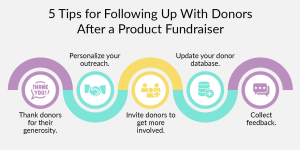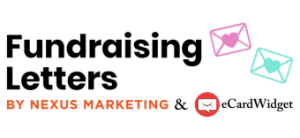Picture this: you’ve just hosted a successful cookie dough fundraiser. Throughout the campaign, you sold delicious treats and watched families come together to bake cookies in support of your cause.
When the campaign ends, you wonder how you can keep the momentum and magic of your product fundraiser alive once the campaign is over. With proper follow-up and donor stewardship, however, you can sustain the relationships you’ve created and encourage long-lasting support.
Whether you’ve hosted tons of fundraisers or just wrapped up your first-ever campaign, these five tips will help you conclude your product fundraiser on a high note and leverage the campaign end as an opportunity to grow your donor relationships.

1. Thank donors for their generosity.
The best place to start with fundraiser follow-up is by sending a simple thank-you. Show donors that you recognize their contributions and appreciate their participation in the campaign.
To ensure your thank-you note is complete, eCardWidget recommends including the following elements:
- A personalized greeting
- A statement of your appreciation
- Your nonprofit’s plans for using the donation
- A short testimonial or story
- Additional engagement opportunities
- A closing and final thank-you
- Signature and contact information
Get creative with your thank-you notes by adding images or sending eCards. That way, your appreciation efforts will be more interactive and exciting for recipients. Just make sure to send your thank-you notes as soon as possible after the campaign ends—preferably within 48 hours—while your nonprofit is still fresh in donors’ minds.
2. Personalize your outreach.
Add a personal touch to your fundraiser follow-up by acknowledging donors’ individuality. Address donors by name and reach out using their preferred communication method.
You can also personalize your outreach to your organization’s mission and goals to make your communications stand out. For instance, let’s say your cheerleading team hosted a product fundraiser to raise money for new uniforms and competition fees.
Instead of sending a generic follow-up email, you can include pictures of team members dressed in their new uniforms at your latest competition to show donors what their funds went toward. Additionally, you might interview one of your team members about what donors’ support means to them and include that testimonial in your follow-up to show donors how much their contributions make a difference to individual team members.
3. Invite donors to get more involved.
Donors have more to offer beyond their monetary contributions. Welcome them to your nonprofit’s community by encouraging them to get involved in other ways.
For example, you may invite donors to your nonprofit’s annual gala. Give them the option of attending the event, helping to secure sponsors, or volunteering to set up beforehand and clean up afterward. That way, they can expand their involvement in your organization in the way that most appeals to them.
4. Update your donor database.
Throughout your fundraiser, you likely collected lots of important information about your donors, especially those who are brand new to your nonprofit. To stay in touch with these supporters, you’ll need to store their contact information in your constituent relationship management platform (CRM).
As you create new donor profiles, consider adding the following data points to steward these new donor relationships:
- Names
- Mailing addresses
- Email addresses
- Phone numbers
- Preferred communication channels
For existing records, add information about donors’ product fundraiser involvement and anything else you learn about them. Perhaps one donor engaged with your social media post about the fundraiser and participated shortly after. This piece of information would be useful to note because you can target this supporter using social media during future campaigns for the best results.
5. Collect feedback.
Hearing your donors’ thoughts about your product fundraiser can improve your approach in the future. For example, you may ask for feedback on the products you sell. ABC Fundraising recommends hosting a popcorn fundraiser since it has high earning potential and caters to a wide audience. You may check to see if donors would be interested in this type of fundraiser or inquire about which popcorn flavors they like best.
In addition to asking about the products themselves, you can also collect feedback on the logistics of your fundraiser by asking questions such as:
- How did you hear about our product fundraiser?
- What did you enjoy about the fundraiser?
- Is there anything we could improve for next time?
- How does this fundraiser compare to others we’ve hosted in the past?
- Would you be interested in participating in this type of fundraiser again?
These types of open-ended questions allow donors to elaborate on their answers and provide you with rich, detailed feedback. Make sure to set aside time for your team to comb through the responses and note any helpful insights.
While the main purpose of your product fundraiser is to raise funds for your cause, it’s also a great opportunity to build upon your connections with donors. When you continue communicating with donors after the final transaction has been made, you show that you care about your donors beyond their monetary contributions and want to create mutually beneficial relationships with them.

